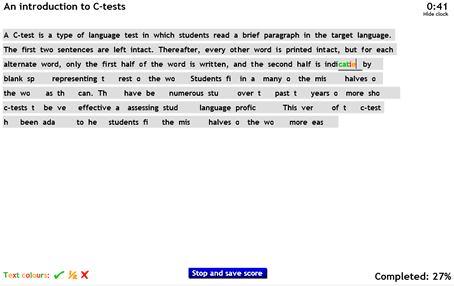
I’m pleased to announce yet another Flash Interactive Multimedia Learning Application to add to the suite of Second Language Acquisition (SLA) software for English for Speakers of Other Languages (ESOL).
What is a C-Test?
A c-test is a type of language test in which learners read a brief paragraph in the target language. The first two sentences are left intact. Thereafter, every other word is left intact but for each alternate word, only the first half of the word is written and the second half is represented by a blank space, e.g. every oth _ _ _ word i_ left int _ _ _. Learners’ ability to fill in the blank spaces indicates their language proficiency according to the reading difficulty of the paragraph used in the test.
The c-test was developed in the 1980s at the Universität Duisburg-Essen in Germany – based on theories of language redundancy relating to Gestalt theory.
How good are C-Tests at determining learners’ language proficiency?
Christine Klein-Braley published a paper titled Theory of C-Test Processing in 1996. In her introduction she wrote:
In virtually all the studies thus far reported, the c-tests have been shown to be highly reliable, with alpha coefficients very often higher that .9, and to have high correlations with whatever other measure was used to represent language proficiency: teacher ratings or judgements, self-assessment procedures, and other language tests and language testing procedures. These validity coefficients have regularly reached .7 and higher. Such high validity coefficients are unusual for any type of test.
Esmat Babaii and Hasan Ansary published a research paper at Shiraz University in Tehran on an objective evaluation of the c-test.
What’s different in this version?
Whereas the original version of the c-test was paper-based and simply put an underscore for each missing letter of the words, e.g. mis _ _ _ _, this version uses a “traffic light” interactive colour coding feedback system which guides learners towards the correct answer, thereby preventing it from becoming a spelling test. It’s also particularly easy to deploy c-tests using this application since all it needs is a paragraph of text in order to generate the test. It accepts paragraph text as XML files or as FlashVars, both of which can be written using a free text editor, through the Moodle SWF Activity Module settings wizard. The C-Test MILA sends the overall time taken and grade to Moodle’s grade book.
What’s next?
I am currently in the process of creating a new Moodle course for the Multimedia Interactive Learning Applications (MILAs). This course will include working examples, documentation and tutorials. Watch this blog for further announcements.